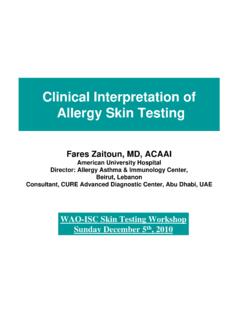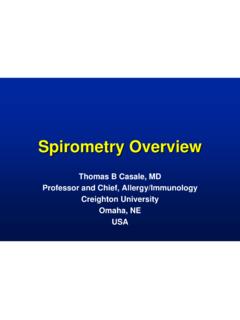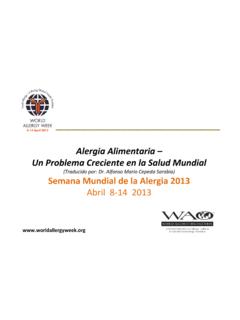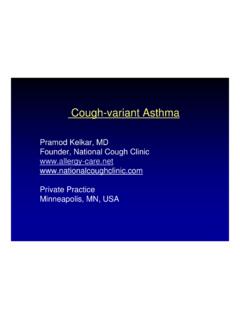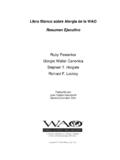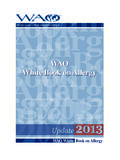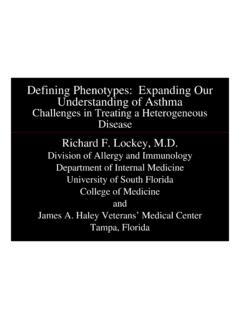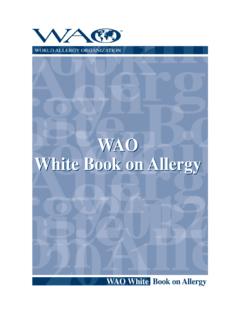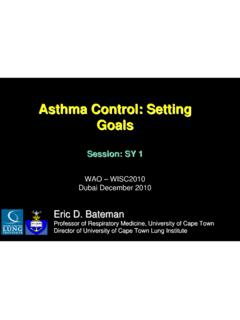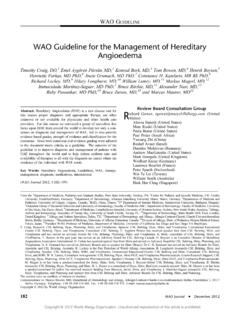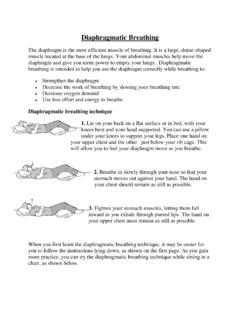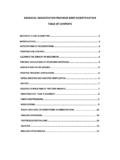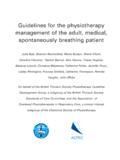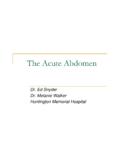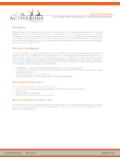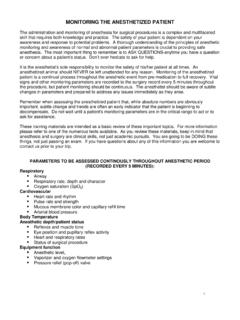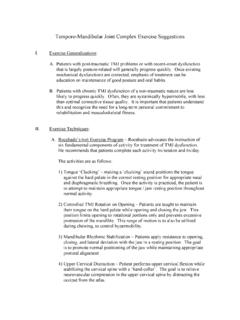Transcription of asthma and vocal cord dysfunction-Ledford
1 asthma and vocal cord DysfunctionAsthma and vocal cord DysfunctionSymposium 6 Symposium 6 Dennis K. ledford , K. ledford , of Medicine and PediatricsProfessor of Medicine and PediatricsUniversity of South FloridaUniversity of South FloridaTampa, FloridaTampa, FloridaUSAUSAO bjectivesObjectives Understand common presentations of vocal cord dysfunction and closely related disorders Understand keys to diagnosis as well as the pitfalls often encountered from patient history, spirometry, laryngoscopy Understand accepted treatment approaches for vocal cord dysfunction Appreciate the need for consensus regarding terminology and the need for prospective controlled study of this disorder. OutlineOutline BackgroundBackground PhenotypesPhenotypes DiagnosisDiagnosis TreatmentTreatmentVCD: Early ReportsVCD: Early Reports 19741974 Downing et al:Downing et al: Factitious AsthmaFactitious asthma 19821982 Patterson et al:Patterson et al: MunchhausenMunchhausen s Stridors Stridor Other terminology:Other terminology.
2 PseudoasthmaPseudoasthma Nonorganic airway obstructionNonorganic airway obstruction Functional upper airway obstructionFunctional upper airway obstruction Spasmodic croupSpasmodic croup Emotional laryngeal wheezingEmotional laryngeal wheezing Psychogenic upper airway obstructionPsychogenic upper airway obstruction Episodic laryngeal dyskinesiaEpisodic laryngeal dyskinesia Episodic laryngeal obstructionEpisodic laryngeal obstruction Psychogenic stridorPsychogenic stridor Episodic paroxysmal laryngospasmEpisodic paroxysmal laryngospasm Irritable larynx syndromeIrritable larynx syndrome Paradoxical vocal fold motionParadoxical vocal fold motion POLOPOLO PPeriodic eriodic OOccurrences of ccurrences of LLaryngeal aryngeal OObstructionbstructionRecently proposed name to replace the term VCDR ecently proposed name to replace the term VCDM orris MJ, Christopher KL Chest 2010;138:1213-13 vocal cord dysfunction vocal cord dysfunction presenting as asthmapresenting as asthmaChristopher KL, Wood RP, et al.
3 NEJM 1983;308:1566 Christopher KL, Wood RP, et al. NEJM 1983;308:1566--7070 5 patients (4 female).5 patients (4 female). None had BHRNone had BHR Adduction of glottis with Adduction of glottis with posterior chinkposterior chink Responsive to speech therapyResponsive to speech therapyProposed VCD Diagnostic CriteriaProposed VCD Diagnostic Criteria The diagnosis is best established by flexible The diagnosis is best established by flexible fiberoptic fiberoptic laryngoscopylaryngoscopy Paradoxical motion of the vocal cordsParadoxical motion of the vocal cords Anterior adduction with posterior chinkAnterior adduction with posterior chink More common to see adduction without chinkMore common to see adduction without chink Paradoxical motion occurs during inspiration or Paradoxical motion occurs during inspiration or during both inspiratory and expiratory phasesduring both inspiratory and expiratory phasesWood RP, Milgrom H JACI 1996 98(3).
4 481-5 RhinolaryngoscopyRhinolaryngoscopy Normal laryngeal Normal laryngeal anatomy andanatomy andphysiologyphysiologyRhinolaryngoscopy RhinolaryngoscopyA. Inspiration B. Phonation A. Inspiration B. Phonation C. SniffC. Sniff VCD can mimic asthma , but it is a distinct disorderVCD can mimic asthma , but it is a distinct disorder VCD may coexist with asthmaVCD may coexist with asthma asthma medications typically do little, if anything, to relieve asthma medications typically do little, if anything, to relieve VCD VCD symptomssymptoms Variable flattening of the inspiratory flow volume loop on Variable flattening of the inspiratory flow volume loop on spirometry is strongly suggestive of VCDspirometry is strongly suggestive of VCD Diagnosis of VCD is from indirect or direct vocal cord Diagnosis of VCD is from indirect or direct vocal cord visualization during an episode, during which abnormal visualization during an episode.
5 During which abnormal adduction can be documentedadduction can be documented VCD should be considered in patients with difficultVCD should be considered in patients with difficult--toto--treat, treat, atypical asthma and in elite athletes who have exercise related atypical asthma and in elite athletes who have exercise related breathlessness unresponsive to asthma medicationbreathlessness unresponsive to asthma medicationVocal cord DysfunctionVocal cord DysfunctionGuidelines for the Diagnosis and Management of AsthmaGuidelines for the Diagnosis and Management of AsthmaNHLBI NAEPP EPR 3 NHLBI NAEPP EPR 3 November, 2007 November, 2007 OutlineOutline BackgroundBackground PhenotypesPhenotypes DiagnosisDiagnosis TreatmentTreatmentA word about Clinical PhenotypesA word about Clinical Phenotypes asthma 4 year old with itchy eyes, runny nose, sneezing and wheezing in late spring during the peak of grass pollen 48 year old without prior atopy who has severe respiratory infection followed by chronic wheezing, dyspnea, and reversible airflow obstruction controlled by the combination of continuous ICS and PRN SABA VCD 15 year old non-atopic elite soccer player with episodic exercise-induced stridor 45 year old with history of chronic anxiety/depression and recurrent dramatic episodes of dyspnea, stridor and multiple intubationsVCD adult phenotype: National Jewish VCD adult phenotype: National Jewish Adult VCD SeriesAdult VCD Series All VCD patients from 1984 to 1991 (95)All VCD patients from 1984 to 1991 (95) 42 VCD alone42 VCD alone 53 VCD + asthma53 VCD + asthma 42 control subjects with severe asthma42 control subjects with severe asthmaNewman et al AJRCCM 152:1382 1995 VCD: National Jewish SeriesVCD.
6 National Jewish SeriesNewman, et al AJRCCM 152:1382 1995 VCDVCDVCD + AsthmaVCD + AsthmaAsthmaAsthmaDuration of SxDuration of + + + + + + dosePrednisone + + + + + + of prednisoneYears of + + + + + + visits in previous yrER visits in previous + + + + + + in previous yrAdmits in previous + + + + + + Intubated 121212121212 VCD: National Jewish SeriesVCD: National Jewish Series Psychiatric Disturbance in 42 VCD patients Psychiatric Disturbance in 42 VCD patients without asthmawithout asthma 73% axis I diagnosis (38% abused)73% axis I diagnosis (38% abused) 37% axis II diagnosis37% axis II diagnosis 21% psychiatric Hospitalization21% psychiatric HospitalizationNewman et al AJRCCM 152:1382 1995 Only psychiatric hospitalizations were significantly different from controlsAge/Sex16/F12/F14/F12/F15/M16/F1 8/FPresenting SymptomsThroat tightness, DyspneaThroat tightness, DyspneaThroat tightness, CoughThroat/Chest tightnessThroat/Chest tightness Voice changes, WheezingThroat tightness, WheezingSportBB, VB, TrSw, ChTae Kwon DoS, SBTr, FBSw, TrVBEIBNoYesNoNoNoNoPsychiatric Diagnosis----Anxiety ----Anxiety &Depression-----Depression------Academic Achievement AAAAAL andwehr et al, Pediatrics 1996; 88:971 Adolescents with VCD Mimicking EIBA dolescents with VCD Mimicking EIBN ormal LarynxNormal cordsVocal vocal cordsFalse vocal Interarytenoid VCD anatomicanatomic Phenotype Phenotype ExamplesExamplesexhalationinhalation#1#2 Clinical Findings from the VCD LiteratureClinical Findings from the VCD LiteratureMorris MJ, Christopher KL Chest 2010.
7 138:1213 Morris MJ, Christopher KL Chest 2010;138:1213--1313> 18 yo792 (70%)<18 yo339 (30%)% female70%Exercise 269 casesPsychiatric/emotional factors270 casesGERD267 casesChemical irritants103 casesURI98 casesIrritable Larynx Syndrome:Irritable Larynx Syndrome:Spectrum of Cough to VCDS pectrum of Cough to VCDB ucca, Rolla, Brussino, Oliva, Bugiani in Allergy, Lancet, JACIC hronic Laryngopharyngeal Acid Chronic Laryngopharyngeal Acid Reflux: Indirect Signs*Reflux: Indirect Signs*ErythemaInterarytenoid edema*not pathognomonic for LPRVCD: Anxiety and other Psychiatric VCD: Anxiety and other Psychiatric IssuesIssues Anxiety Anxiety cause or effect?cause or effect? Some patients have conversion disorderSome patients have conversion disorder Others appear to have PTSD patternOthers appear to have PTSD pattern Hx of sexual abuseHx of sexual abuse Associated with health care professionals and family Associated with health care professionals and family membersmembers Diagnosis of asthma , concern about asthma , side Diagnosis of asthma , concern about asthma , side effects of asthma medicationseffects of asthma medications Others no primary psychopathology ( adolescent)Others no primary psychopathology ( adolescent)
8 Perfectionist or obsessive/compulsive tendenciesPerfectionist or obsessive/compulsive tendencies Controlled studies necessary but near impossibleControlled studies necessary but near impossibleOutlineOutline BackgroundBackground PhenotypesPhenotypes DiagnosisDiagnosis TreatmentTreatment VCD can mimic asthma , but it is a distinct disorderVCD can mimic asthma , but it is a distinct disorder VCD may coexist with asthmaVCD may coexist with asthma asthma medications typically do little, if anything, to relieve asthma medications typically do little, if anything, to relieve VCD VCD symptomssymptoms Variable flattening of the inspiratory flow volume loop on Variable flattening of the inspiratory flow volume loop on spirometry is strongly suggestive of VCDspirometry is strongly suggestive of VCD Diagnosis of VCD is from indirect or direct vocal cord Diagnosis of VCD is from indirect or direct vocal cord visualization during an episode, during which abnormal visualization during an episode, during which abnormal adduction can be documentedadduction can be documented VCD should be considered in patients with difficultVCD should be considered in patients with difficult--toto--treat, treat.
9 Atypical asthma and in elite athletes who have exercise related atypical asthma and in elite athletes who have exercise related breathlessness unresponsive to asthma medicationbreathlessness unresponsive to asthma medicationVocal cord DysfunctionVocal cord DysfunctionGuidelines for the Diagnosis and Management of AsthmaGuidelines for the Diagnosis and Management of AsthmaNHLBI NAEPP EPR 3 NHLBI NAEPP EPR 3 November, 2007 November, 2007 Spirometry and Flow LoopSpirometry and Flow Loop FEV1 (88% of predicted),no bronchodilator response FEV1 (88% of predicted),no bronchodilator response Flattened inspiratory loopSpirometry and Flow Volume Spirometry and Flow Volume Loops: Loops: Variable extraVariable extra--thoracic obstructionthoracic obstructionFEVFEV11 FVCFVCFEVFEV11/ FVC/ FVCFEFFEF2525--7575 FEFFEF5050/ FIF/ (99%) (99%) (96%) (96%). (155%) (155%) and Lung Function Variables Clinical and Lung Function Variables Associated with VCDA ssociated with VCD Comparison of spirometry and laryngoscopic Comparison of spirometry and laryngoscopic findings in 226 patients evaluated for VCDfindings in 226 patients evaluated for VCD Included retrospective flow volume loop Included retrospective flow volume loop interpretation by 3 pulmonologists blinded to interpretation by 3 pulmonologists blinded to laryngoscopy resultlaryngoscopy resultWatson et al.
10 Respiratory Care 2009 54(4):467-473 Clinical and Lung Function Variables Clinical and Lung Function Variables Associated with VCDA ssociated with VCD 100 confirmed to have VCD via laryngoscopy100 confirmed to have VCD via laryngoscopy Inspiratory flow volume loop was Inspiratory flow volume loop was normalnormalin the in the Majority of confirmed VCD casesMajority of confirmed VCD cases Roughly 1/3 of cases Roughly 1/3 of cases withoutwithoutVCD were judged to VCD were judged to have truncated inspiratory loophave truncated inspiratory loop AuthorsAuthors conclusions:conclusions: VCD remains difficult to predict with spirometry or flowVCD remains difficult to predict with spirometry or flow--volume loops. volume loops. If VCD is suspected, normal flowIf VCD is suspected, normal flow--volume loop patterns should volume loop patterns should not influence the decision to perform laryngoscopynot influence the decision to perform laryngoscopyWatson et al.
